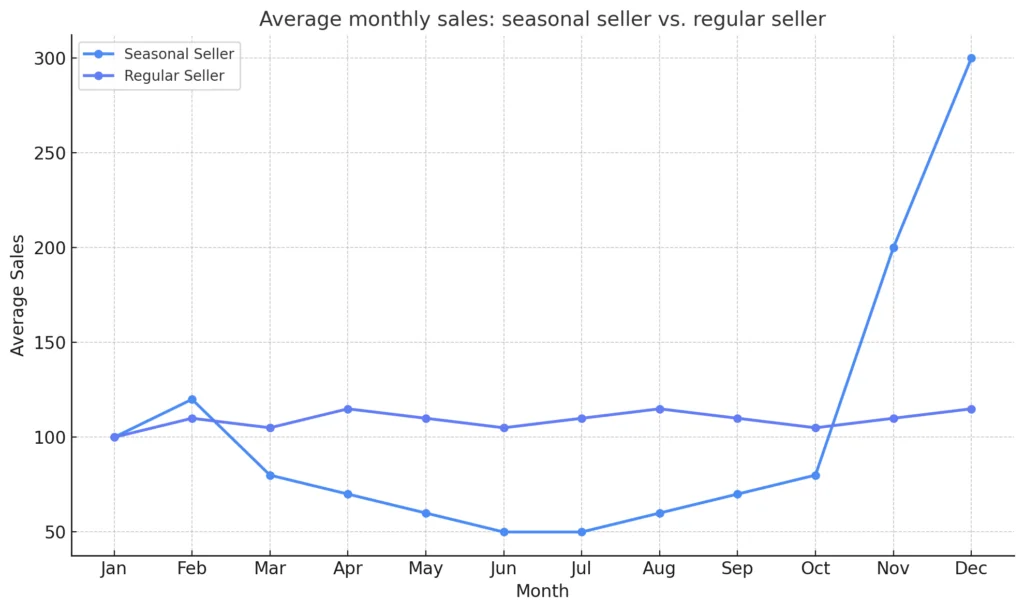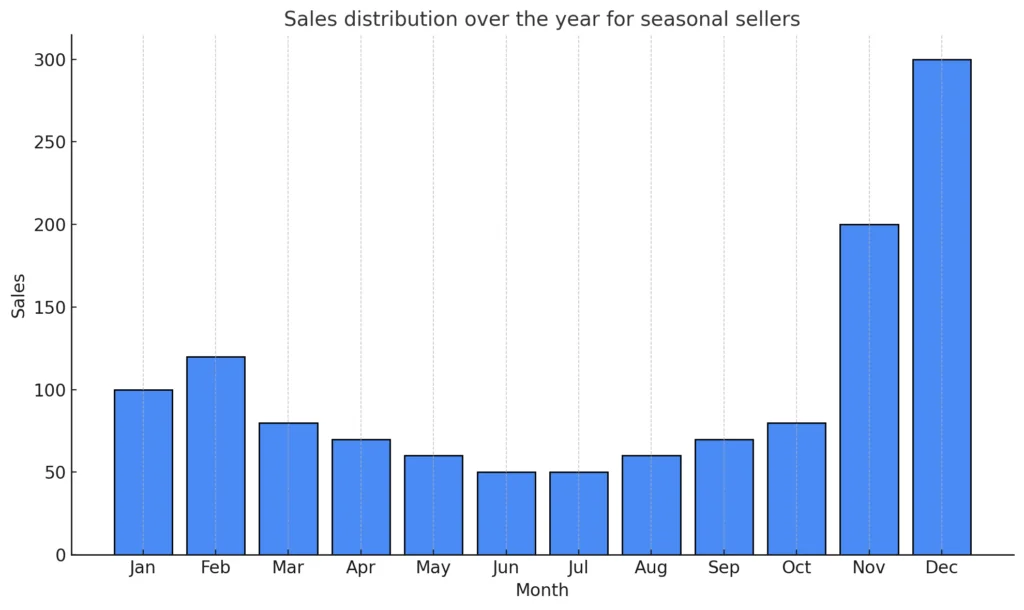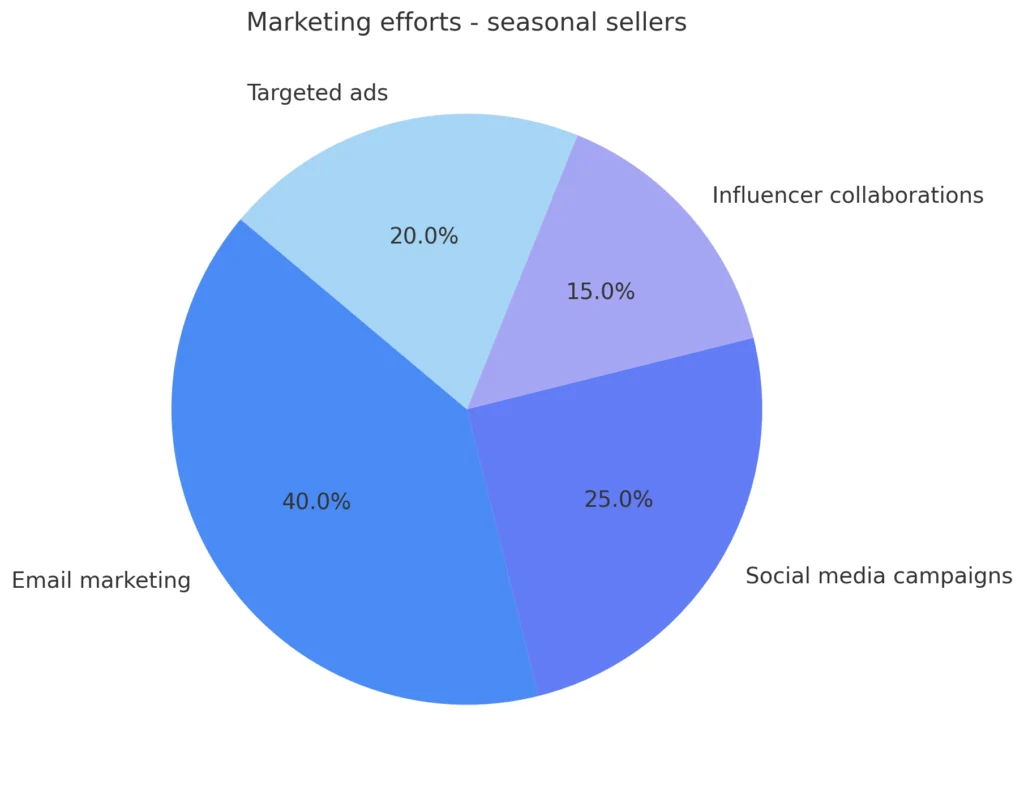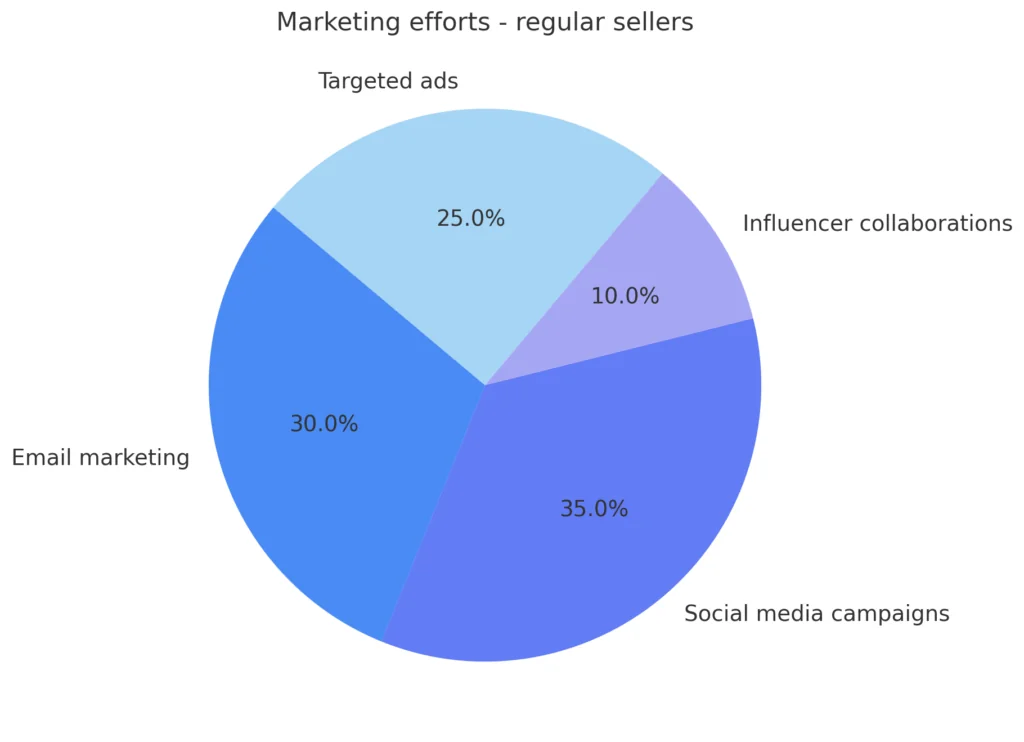Understanding your selling patterns is a crucial step in optimizing your business strategy as an eCommerce seller. Whether you’re a seasoned entrepreneur or just starting out, knowing whether you are a seasonal seller or a regular seller can significantly impact your approach to marketing, inventory management, and financial planning.
Different selling types come with their own set of challenges and opportunities, and recognizing which category you fall into is the first step toward maximizing your potential.
This article aims to help you identify your seller type – whether you experience peaks and valleys in sales due to seasonal trends, or whether you maintain steady sales throughout the year. By understanding the characteristics and behaviors that define seasonal and regular sellers, you can tailor your strategies to suit your unique business needs.
We will provide you with practical insights and actionable strategies tailored to each seller type, ensuring that you can navigate the complexities of the eCommerce landscape with confidence.
As part of the article, we have included a self-test designed to help you pinpoint your seller type. This quick assessment will guide you through key questions about your product offerings, sales patterns, and marketing efforts, providing you with a clear understanding of your eCommerce selling style.
By the end of this article, you’ll not only know whether you are a seasonal or regular seller (or a hybrid of the two!), but also how to leverage this knowledge to enhance your business performance.

Understanding seasonal sellers
1. Definition
A seasonal seller is an eCommerce business that experiences significant fluctuations in sales based on specific times of the year. These sellers thrive during peak seasons, when demand for their products skyrockets, and sales are at their highest. Typical examples of seasonal products include holiday decorations, which see a surge in demand during the festive season, or swimwear, which peaks in popularity during the summer months.
Seasonal sellers often have distinct sales patterns, with clear periods of high activity followed by quieter times.
Subscribe to the eCommerce newsletter for
top industry insights
2. Characteristics and behaviors of seasonal sellers
Seasonal sellers are characterized by their ability to capitalize on trends and timing. They often stock products that are tied to specific events, holidays, or seasons.
For instance, an eCommerce store specializing in Christmas decorations will see a significant uptick in sales as the holiday season approaches, while remaining relatively quiet during other parts of the year.
Similarly, a business selling summer apparel will experience its peak during the warmer months. These sellers typically plan their inventory and marketing strategies around these high-demand periods to maximize their sales potential.
3. Seasonal seller – advantages
There are several benefits to operating as a seasonal seller. One of the main advantages is the potential for high sales during peak times. By focusing marketing efforts and resources on these specific periods, seasonal sellers can achieve impressive sales figures in a relatively short amount of time.
This targeted approach allows for concentrated advertising campaigns and promotional activities that align with consumer interest, leading to increased visibility and sales.
4. Seasonal seller – challenges
Despite the cons, being a seasonal seller also comes with its own set of challenges. One of the primary drawbacks is the fluctuation in revenue throughout the year. While peak seasons can bring in significant profits, the off-season periods may result in minimal sales, posing a risk to consistent cash flow.
Additionally, managing inventory can be more complex for seasonal sellers. They must accurately predict demand to avoid overstocking or understocking, both of which can lead to financial losses. Balancing these factors requires careful planning and a keen understanding of market trends and consumer behavior.
5. Case study: How DAVAN Strategic capitalized on the holiday season
DAVAN Strategic, founded by eCommerce veterans Ryan Sherrard and David Lang, leveraged their extensive experience to achieve remarkable revenue during the holiday season. By focusing on strategic keyword research and optimizing their listings for holiday shoppers, they maximized visibility and conversions.
They emphasized the importance of fresh keyword research, targeting emerging trends, and using cross-selling tactics to boost overall sales. Their meticulous planning ensured that their inventory was well-stocked and ready for the Black Friday and Cyber Monday rush, avoiding the costly pitfalls of stockouts.

The success of DAVAN Strategic during the holiday season can also be attributed to their effective management of logistics and inventory. Ryan and David ensured their inventory was dispersed across fulfillment centers by early December, ready to meet the surge in demand.
By utilizing promotional strategies and maintaining competitive pricing, they kept pace with competitors and maintained high visibility in their product categories. Their approach not only drove significant revenue during Q4 but also laid the groundwork for sustained growth beyond the holiday season.
Might also interest you:
- The ultimate guide to seasonal inventory management
- BFCM: The ultimate guide to eCommerce sales [2024]
- 22 Black Friday tips eCommerce experts wish they knew sooner
Tailored strategies for seasonal sellers
Seasonal sellers can greatly benefit from strategies that maximize their sales during peak times and sustain their business during off-seasons. Here are some tailored approaches to help seasonal sellers optimize their operations:
1. Marketing strategies for maximizing sales during peak seasons
To make the most of peak seasons, it’s crucial to have a robust marketing plan in place. Start by creating a buzz well before the season begins. Use social media campaigns, email marketing, and targeted ads to build anticipation and attract potential customers. Highlight limited-time offers, seasonal discounts, and exclusive products to create a sense of urgency.
You should also consider collaborating with influencers and running special promotions to boost visibility and drive traffic to your store. Leveraging seasonal themes in your marketing materials can also resonate with customers and increase engagement.
2. Inventory management tips to handle high demand and off-season storage
Effective inventory management is key to meeting high demand during peak seasons and ensuring smooth operations during quieter periods. Before the season starts, analyze past sales data to forecast demand accurately and plan your stock levels accordingly. Consider using inventory management software to track stock levels in real-time and automate reordering processes.
During peak seasons, ensure you have adequate stock to avoid running out of popular items. For off-season periods, explore options like temporary storage solutions or off-season sales to manage excess inventory and free up space.
3. Financial planning for handling revenue fluctuations
Seasonal businesses often face significant revenue fluctuations, which can impact cash flow and financial stability. To manage this, create a detailed financial plan that includes budgeting for both peak and off-season periods.
Popular content
- 14 strategies to improve your eCommerce business’s financial health
- 50+ ChatGPT prompts to elevate your eCommerce business
- A guide to pricing your product on Amazon
- 5 marketing metrics all eCommerce businesses should track
- All about Amazon PPC
Set aside a portion of your peak season profits to cover expenses during slower months. Explore financing options like lines of credit or short-term loans to bridge any cash flow gaps. Regularly review your financial statements to monitor your business’s health and adjust your spending as needed to maintain stability throughout the year.
4. Customer engagement tactics to maintain interest year-round
Keeping customers engaged year-round is essential for maintaining a loyal customer base. Develop a content calendar that includes regular updates, blog posts, and social media content to stay connected with your audience. Offer off-season promotions, loyalty programs, and exclusive previews of upcoming products to keep customers interested. Use email marketing to share useful information, special deals, and personalized recommendations based on past purchases.
Engaging with customers through feedback surveys and responding to their inquiries promptly can also foster long-term relationships and encourage repeat business.
By implementing these tailored strategies, seasonal sellers can optimize their marketing efforts, manage inventory effectively, plan financially for fluctuations, and keep customers engaged throughout the year.

Understanding regular sellers
1. Definition
A regular seller is an eCommerce business owner who experiences consistent demand for their products throughout the year, without significant fluctuations tied to specific seasons or events.
These sellers enjoy steady sales patterns and gradual growth, making them a reliable presence in the market. Products sold by regular sellers often include everyday essentials such as electronics, clothing, and household items that consumers need and purchase regularly.
2. Characteristics and behaviors of regular sellers
Regular sellers typically offer products with a consistent demand, allowing them to maintain steady sales month after month. For example, an online store selling electronics like smartphones and accessories, or clothing items such as casual wear and basics, caters to ongoing consumer needs.
These sellers benefit from predictable sales patterns and can plan their inventory and marketing strategies with greater accuracy. They often engage in continuous marketing efforts to keep their brand visible and relevant in a competitive market.
An example of a regular seller who stays up to speed with the holiday season is Tanya Zhang, co-founder of Nimble Made:
As a men’s shirt brand, we do observe seasonality in our sales especially during holiday seasons in November and December as those are high-gifting seasons. However, our shirts are designed so they’re season-less, offering year-round high-quality men’s shirts that can be worn to the office or events like weddings no matter the time of year.
Tanya Zhang Co-founder, Nimble Made

3. Regular seller – advantages
One of the main advantages of being a regular seller is the steady income that comes from consistent demand. This reliable revenue stream allows for better financial planning and stability, reducing the risks associated with seasonal fluctuations.
Inventory management is generally easier for regular sellers, as they can maintain more consistent stock levels without the need for significant adjustments. This predictability helps streamline operations and reduces the likelihood of overstocking or stockouts.
4. Regular seller – challenges
Just like seasonal sellers, regular sellers also face their own set of challenges. One of the primary cons is the constant competition in the market. Since regular sellers often operate in highly saturated niches, they must continually differentiate themselves from competitors to attract and retain customers. This requires ongoing marketing efforts to stay top-of-mind and maintain a loyal customer base.
Additionally, regular sellers need to innovate and adapt to changing consumer preferences and market trends to remain relevant and competitive.
5. Case study: How Underoutfit scaled to 7 figures in 6 months and beat inventory challenges
Underoutfit, a shapewear line, achieved remarkable success in 2021, scaling from 0 to 7 figures in just 11 months. The founders, experienced eCommerce entrepreneurs, focused on delivering high-quality products and exceptional customer service. Their commitment to ensuring everyday comfort led to a strong customer base and repeat purchases.
However, this rapid growth also presented significant inventory challenges, with stockouts threatening their momentum. By partnering with 8fig, Underoutfit secured the flexible funding needed to maintain inventory levels, preventing stockouts and supporting their continued expansion.

The key to Underoutfit’s success lies in their proactive approach to inventory management and customer satisfaction. As demand surged, they quickly realized the importance of staying in stock to avoid the pitfalls of selling out, which can disrupt customer experience and marketing efforts.
The partnership with 8fig allowed Underoutfit to build a long-term growth plan, ensuring they could meet demand and scale effectively. This strategic approach not only helped them navigate logistical hurdles but also positioned them for continued growth, even during peak sales events like Black Friday and Cyber Monday.
Tailored strategies for regular sellers
Regular sellers benefit from strategies designed to sustain steady growth, maintain consistent stock levels, ensure reliable cash flow, and build a loyal customer base. Here are some tailored approaches to help regular sellers optimize their operations:
1. Marketing strategies for sustaining steady growth
To sustain steady growth, regular sellers should focus on continuous marketing efforts. Develop a comprehensive marketing plan that includes a mix of digital advertising, content marketing, social media engagement, and email campaigns. Use data analytics to understand customer behavior and preferences, allowing you to create targeted marketing messages that resonate with your audience.
Regularly update your website with fresh content, new products, and special offers to keep customers engaged. Collaborating with influencers and leveraging user-generated content can also enhance your brand’s visibility and credibility.
2. Inventory management tips for maintaining stock levels
Effective inventory management is crucial for regular sellers to meet consistent demand. Implement an inventory management system that tracks stock levels in real-time and automates reordering processes. Conduct regular inventory audits to identify slow-moving items and adjust your stock accordingly.
Utilize demand forecasting tools to predict future sales and ensure you have the right amount of inventory on hand. Maintaining optimal stock levels reduces the risk of stockouts and overstocking, enhancing operational efficiency and customer satisfaction.
3. Financial planning for consistent cash flow
Consistent cash flow is vital for the stability and growth of regular sellers. Develop a detailed financial plan that includes budgeting for all aspects of your business, from inventory purchases to marketing expenses. Monitor your cash flow regularly and adjust your spending as needed to maintain financial health.
Consider diversifying your revenue streams by offering subscription services, upselling, or cross-selling related products. Building strong relationships with suppliers can also provide opportunities for favorable payment terms and discounts, improving your cash flow management.
4. Customer engagement tactics to build a loyal customer base
Building a loyal customer base requires ongoing engagement and exceptional customer service. Implement a customer loyalty program that rewards repeat purchases and encourages long-term relationships.
Personalize your marketing efforts by segmenting your audience and tailoring messages to their specific interests and buying behaviors. Provide excellent customer support through multiple channels, including live chat, email, and social media.
Encourage customer feedback and use it to improve your products and services. Engaging customers through regular newsletters, social media interactions, and exclusive offers can foster loyalty and drive repeat business.
By implementing these tailored strategies, regular sellers can sustain steady growth, maintain optimal stock levels, ensure consistent cash flow, and build a loyal customer base. These approaches help regular sellers navigate the competitive eCommerce landscape and achieve long-term success.
Quiz yourself: Are you a seasonal or regular seller?
Determining whether you are a seasonal or regular seller can help you tailor your business strategies for optimal success. Take this self-assessment quiz to find out your seller type. Answer the following questions, then use the scoring guide to identify your selling style:
What type of products do you primarily sell?
- A. Products tied to specific seasons or holidays (e.g., holiday decorations, swimwear)
- B. Products with consistent demand year-round (e.g., electronics, clothing)
- C. A mix of both seasonal and year-round products
How do your sales typically fluctuate throughout the year?
- A. Significant spikes during certain times, with quieter periods in between
- B. Steady and consistent sales throughout the year
- C. Moderate fluctuations with some high and low periods
How do you plan your marketing campaigns?
- A. Focused around peak seasons with intensive marketing efforts during those times
- B. Continuous marketing efforts to maintain steady visibility and engagement
- C. A combination of both, with heightened efforts during certain seasons


How do you manage your inventory?
- A. Stock up heavily before peak seasons and reduce stock during off-seasons
- B. Maintain consistent stock levels with regular restocking based on ongoing demand
- C. Adjust inventory levels moderately based on anticipated demand fluctuations
What are your main financial concerns?
- A. Managing cash flow during off-season periods
- B. Competing in a saturated market and maintaining consistent cash flow
- C. Balancing cash flow with moderate seasonal variations
How do you engage with your customers?
- A. Peak season promotions, followed by limited off-season interactions
- B. Regular engagement through loyalty programs, newsletters, and consistent customer support
- C. A mix of peak season promotions and regular engagement efforts
What is your approach to product launches?
- A. Introduce new products primarily during peak seasons
- B. Launch new products periodically throughout the year
- C. A blend of seasonal launches and periodic new product introductions
Scoring guide
Mostly A’s: You are likely a seasonal seller
As a seasonal seller, you experience significant fluctuations in demand based on specific times of the year. Your sales peak during certain seasons or holidays, and you focus your marketing and inventory efforts around these periods. To maximize your success, concentrate on strategies that enhance your peak season performance and manage the challenges of off-season periods effectively.
Mostly B’s: You are likely a regular seller
As a regular seller, you enjoy steady and consistent demand for your products year-round. Your business benefits from predictable sales patterns and ongoing customer engagement. Focus on continuous marketing efforts, efficient inventory management, and building long-term customer loyalty to sustain and grow your business in a competitive market.
Mostly C’s: You are likely a hybrid seller
As a hybrid seller, you have elements of both seasonal and regular selling. You experience moderate fluctuations with certain peak periods and consistent demand for some products year-round. To optimize your business, blend strategies for both seasonal and regular sellers. Leverage peak seasons to maximize sales while maintaining steady efforts to ensure consistent income throughout the year.
| Category | Seasonal eCommerce sellers | Regular eCommerce sellers |
|---|---|---|
| Revenue peaks | High revenue peaks during specific seasons or events | Steady and consistent revenue throughout the year |
| Inventory management | Can plan inventory purchases around peak seasons | Requires constant inventory management and replenishment |
| Marketing strategy | Focused marketing efforts during key seasons/events | Ongoing marketing efforts to maintain continuous sales |
| Customer engagement | Intense customer engagement during peak periods | Consistent customer engagement, fostering long-term loyalty |
| Operational intensity | High intensity during peak seasons, lower off-peak | Consistent operational workload throughout the year |
| Cash flow | Significant cash flow influx during peak seasons | Steady cash flow, easier to predict and manage |
| Risk management | Risk of overstocking or understocking for peak seasons | More predictable demand, less risk of stock issues |
| Promotions and discounts | Can use off-peak times to clear out inventory | Can run promotions and discounts year-round to boost sales |
| Staffing needs | May need temporary staff during peak seasons | Stable staffing needs, easier to manage |
| Growth opportunities | Can leverage seasonal trends for rapid growth | Can build a stable and scalable business over time |
Conclusion
Understanding your selling type – whether you are a seasonal, regular, or maybe a hybrid seller – is crucial for optimizing your eCommerce business. Each seller type comes with unique characteristics, advantages, and challenges that require tailored strategies.
Seasonal sellers thrive during peak times with focused marketing efforts and careful inventory management, while regular sellers benefit from steady sales and consistent customer engagement. Hybrid sellers, experiencing elements of both, can blend strategies to balance peak season highs with year-round stability.
Use the insights from the self-assessment portion to identify your seller type and apply the tailored strategies discussed in this article. By aligning your efforts with your sales patterns, you can achieve greater success and enhance your business performance. Understanding your selling type and implementing the right strategies can help you navigate the complexities of the eCommerce landscape more effectively.
To take your eCommerce business to the next level, consider partnering with 8fig for expert guidance, AI-based financial management tools, and a flexible Growth Plan tailored just for you.
Have article ideas, requests, or collaboration proposals? Reach out to us at editor@8fig.co – we’d love to hear from you.
- 14 strategies to improve your eCommerce business’s financial health
- New technologies that are changing the eCommerce fashion industry – everything you need to know
- Why just-in-time funding is the future for eCommerce
- BFCM: The ultimate guide to eCommerce sales [2024]
- 7 reasons successful eCommerce sellers opt for funding to fuel growth instead of relying on profits
She's a former English teacher who's passionate about the written word, all while embracing the AI revolution and its countless benefits.
Subscribe to the eCommerce newsletter for
top industry insights
to our blog
Read the latest
from 8fig

AI is quietly reshaping eCommerce. Karma’s Hadas Bar-Ad explores how today’s sellers are using intelligent tools to streamline operations, boost efficiency, and drive smarter growth.

WhatsApp isn’t just for memes and group chats anymore. With a 98% open rate, it’s the secret weapon your eCommerce marketing strategy might be missing. Here’s how to do it right.

Stuck with extra inventory after Amazon’s Spring Sale? Learn five smart strategies to clear unsold stock, boost cash flow, and avoid future overstocks with smarter inventory planning.
